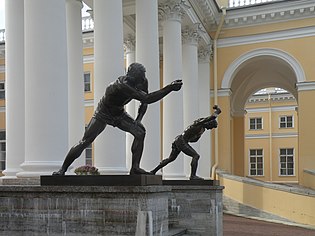Nikolai Stepanovich Pimenov (Russian: Никола́й Степа́нович Пи́менов; 24 November 1812, Saint Petersburg — 5 December 1864, Saint Petersburg) was a Russian sculptor. His father was the sculptor, Stepan Pimenov.


Biography
editHe studied at the Imperial Academy of Arts from 1824 to 1833; with his father and Samuil Galberg. During his time there, he received several silver medals, and a small gold medal for his rendering of Hector reproaching Paris (1833). He was a pensioner (grant recipient) of the academy from 1833 to 1836.[1]
In 1836, he and Alexander Loganovsky presented a pair of statues with an unusual theme; two young men playing popular games (svaika and babka). They were awarded a large gold medal, and received praise from Alexander Pushkin. The following year, thanks to major grant, he was able to make a lengthy stay in Italy, where he spent time in Florence and Rome; modelling from nature. A work he created there in 1842, "Boy Begging for Alms", was instrumental in his being named an Academician in 1844.
He returned to Russia in 1850. Among his first works were a "Resurrection" and "Transfiguration", placed in two attics at Saint Isaac's Cathedral. In recognition of these works, he was named a Professor by the academy, in 1854. Shortly after, he became the Staff Professor of sculpture, and was named to the Academic Council. He taught from 1856 until his death.[2]
He attempted to introduce Nationalist motifs into Classical sculpture. His students included Mark Antokolsky, Matvey Chizhov, and Fyodor Kamensky.
References
edit- ^ Sergey Kondakov, Jubilee Directory of the Imperial Academy of Arts. 1764-1914 (anniversary reference book), Golike / Vilborg, 1915 — pp.266-267, 454
- ^ "Члены совета: // Импер. академия художеств: // Министерство императорского двора". Адрес-календарь. Общая роспись всех чиновных особ в государстве, на 1862 — 1863 год. Часть I. Власти и места центрального управления и ведомства их. СПб.: Printing House of the Academy of Sciences. 1862.
Further reading
edit- Krivdina, Olga A. (2007). Профессор скульптуры Николай Степанович Пименов, 1812–1864 (in Russian). St. Petersburg: Sudarynya. ISBN 5-88718-010-2.
- Petrov, Pyotr N. (1865). "Профессор скульптуры Николай Степанович Пименов (1812–1864 г.)". In Imperial Academy of Arts, Saint Petersburg (ed.). Отчет Императорской Академии художеств с 1 сентября 1863 по 4 ноября 1864 г. (in Russian). St. Petersburg: Gogenfeld & Co. pp. 128–157, published as standalone book in 1883; republished in Krivdina 2007, add. 14, pp. 326–345
{{cite book}}: CS1 maint: postscript (link) - Ramazanov, Nikolai A. (2014). Belyaev, Nikolai S. (ed.). Материалы для истории художеств в России (PDF) (in Russian). St. Petersburg: Library of the Russian Academy of Sciences. ISBN 978-5-336-00162-4. OCLC 952577337.
- Shmidt, Igor M. (1954). "Николай Степанович Пименов". In Leonov, Alexei I. (ed.). Русское искусство: очерки о жизни и творчестве художников. Первая половина девятнадцатого века (in Russian). Moscow: Iskusstvo. pp. 435–452. OCLC 489749250.
- Sobko, Nikolai P. [in Russian] (1899). "Пименов, Николай Степанович". Словарь русских художников (in Russian). Vol. 3. St. Petersburg: M. Stasyulevich. cols. 222–254. OCLC 889716402.
External links
edit- Nikolai Pimenov at the Russian Academy of Arts' official website (in Russian)
- Biography of Pimenov from the Encyclopedia of 100 Great Sculptors